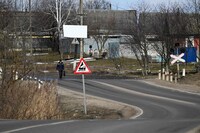The Bryansk regional governor, Alexander Bogomaz, wrote on Telegram that border guards from Russia’s Federal Security Service, the FSB, had “thwarted an attempt to penetrate the territory of the Russian Federation.”
Bogomaz said that a group of 20 people had tried to enter the village of Sluchevsk, which lies just a few miles from the border with Ukraine. “Units of the Armed Forces of the Russian Federation, together with units of the border troops, inflicted a fire defeat on the enemy,” he wrote.
Baza, which reported the explosion, also wrote that “a group of saboteurs” had tried to enter Sluchevsk and that “a battle” had occurred. Its report said that 15 people had been forced back across the border into Ukraine. So far, no video footage of the battle, or of the blast, has been posted.
The incident echoed an attack under similarly murky circumstances in the same border region in early March. Then, the Kremlin cited a “terrorist attack,” which it blamed on Ukraine with Russian President Vladimir Putin saying that assailants had “opened fire on civilians.”
In that incident, Bogomaz reported that two people were killed and hostages were taken. Kyiv denied any involvement. Members of a right-wing group called the Russian Volunteer Corps, which opposes Putin and is fighting on Ukraine’s side in the war, issued a video in which they claimed responsibility.
On Thursday, the Russian Volunteer Corps again claimed to have crossed the Ukraine-Russia border. A video published by the group appears to show armed Russian-speaking men visiting Sluchevsk and speaking with residents. This is followed by footage of fighters firing ammunition and guns at unseen targets in the middle of a village. The video could not be independently verified.
The group rebutted the governor’s claims of “a fire defeat,” telling Polygon media that there were “no losses” and that the group had left the area long before.
Meanwhile, the Russian Finance Ministry on Friday reported that oil and gas revenue had dropped by 45 percent in the first quarter of 2023 compared with the same period a year ago, according to preliminary government estimates.
Data released by the ministry showed a significant decrease in oil and gas revenue, to $20 billion, from about $65 billion in the first quarter of 2022. According to the ministry, the decrease was due to a drop in oil prices and a reduction in natural gas exports. In March 2023, revenue from fuel and energy products totaled about $8.6 billion dollars.
The new data is the latest indication of Russia’s economic woes, as Western sanctions and other punitive measures began to bite. Russian industrial output in February fell 1.7 percent year-over-year following a 2.4 percent drop in January, according to data from Russia’s federal statistics service, Rosstat.
Although Russia’s economy initially proved to be resilient after sanctions, export controls and other measures were put in place, analysts say Russia’s budget has begun to feel the pinch. Massive state spending and increased military production are helping to keep industry in the country afloat, but it’s not clear how long that can be sustained.
After previously hailing a new era of “economic sovereignty,” claiming Western sanctions had backfired, Russian President Vladimir Putin last month warned of economic troubles ahead. “The sanctions imposed against the Russian economy in the medium term could really have a negative impact,” Putin said at a government meeting.
Also on Friday, the Russian Foreign Ministry confirmed that Alexey Moskalyov, the father of a 13-year-old girl who drew an antiwar drawing in class, was in detention in Belarus. He had previously fled house arrest in Russia. A decision about whether to extradite Moskalyov to Russia was pending, the ministry said.
The Moskalyovs’ case, in which the father was convicted last month of discrediting the Russian army, has transfixed the country. On Thursday, a judge held a hearing to consider custody plans for Moskalyov’s daughter, Maria, who had been placed in an orphanage, but a decision was postponed because the father’s whereabouts were unknown.
Maria has been released into the custody of her mother, from whom she had been estranged for seven years.
As Russia appears to be increasing pressure on its citizens and journalists, Russian Deputy Foreign Minister Sergei Ryabkov met with U.S. Ambassador to Russia Lynne M. Tracy to discuss the detention of Evan Gershkovich, a Wall Street Journal reporter who is an American citizen. Gershkovich has been accused of spying for the United States, charges that he and the Journal strongly deny.
In a statement, the Foreign Ministry said the meeting was used to draw Tracy’s attention “to the serious nature of the charges.” The statement said, “It was highlighted that he had been caught red-handed while attempting to access secret information, using his journalistic status as a cover for wrongful actions classed as espionage.”
Russia has so far provided no evidence of its claims, and the Biden administration has demanded that Gershkovich be released.
The Journal says Gershkovich is a hostage. Colleagues, family and friends are pressing for his release.
In its statement, the ministry said: “The hype around this case in the U.S., aimed at putting pressure on the Russian authorities and the court that must decide Gershkovich’s fate, is hopeless and pointless.”



